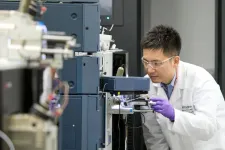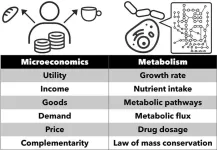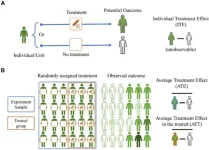(Press-News.org) From Aristotle’s musings on the nature of time to Einstein’s theory of relativity, humanity has long pondered: how do we perceive and understand time? The theory of relativity posits that time can stretch and contract, a phenomenon known as time dilation. Just as the cosmos warps time, our neural circuits can stretch and compress our subjective experience of time. As Einstein famously quipped, “Put your hand on a hot stove for a minute, and it seems like an hour. Sit with a pretty girl for an hour, and it seems like a minute”.
In new work from Champalimaud Research’s Learning Lab published in the journal Nature Neuroscience, scientists artificially slowed down, or sped up, patterns of neural activity in rats, warping their judgement of time duration and providing the most compelling causal evidence so far for how the brain’s inner clockwork guides behaviour.
In contrast to the more familiar circadian clocks that govern our 24-hour biological rhythms and shape our daily lives, from sleep-wake cycles to metabolism, much less is known about how the body measures time on the scale of seconds to minutes. The study focused precisely on this seconds-to-minutes timescale at which much of our behaviour unfolds, whether you’re waiting at a stop light or serving a tennis ball.
The Population Clock Hypothesis
Unlike the exact ticking of a computer’s centralised clock, our brains maintain a decentralised and flexible sense of time, thought to be shaped by the dynamics of neuronal networks dispersed across the brain. In this “population clock” hypothesis, our brains keep time by relying on consistent patterns of activity evolving in groups of neurons during behaviour.
Joe Paton, the study’s senior author, likens this to dropping a stone into a pond. “Each time a stone is dropped, it creates ripples that radiate outward on the surface in a repeatable pattern. By examining the patterns and positions of these ripples, one can deduce when and where the stone was dropped into the water”.
“Just as the speed at which the ripples move can vary, the pace at which these activity patterns progress in neural populations can also shift. Our lab was one of the first to demonstrate a tight correlation between how fast or slow these neural ‘ripples’ evolve and time-dependent decisions”.
The researchers trained rats to distinguish between different intervals of time. They found that activity in the striatum, a deep brain region, follows predictable patterns that change at different speeds: when animals report a given time interval as longer, the activity evolves faster, and when they report it as shorter, the activity evolves more slowly.
However, correlation does not imply causation. “We wanted to test whether variability in the speed of striatal population dynamics merely correlates with or directly regulates timing behaviour. To do that, we needed a way to experimentally manipulate these dynamics as animals reported timing judgements”.
Unravelling Time with Temperature
“Never throw away old tools”, smiles Tiago Monteiro, one of the study’s lead authors. To establish causation, the team turned to an old-school technique in the neuroscientist’s toolbox: temperature. “Temperature has been used in previous studies to manipulate the temporal dynamics of behaviours, such as bird song. Cooling a specific brain region slows down the song, while warming speeds it up, without altering its structure. It’s akin to changing the tempo of a musical piece without affecting the notes themselves. We thought temperature could be ideal as it would potentially allow us to change the speed of neural dynamics without disrupting its pattern”.
To test this tool in rats, they developed a custom thermoelectric device to warm or cool the striatum focally, while simultaneously recording neural activity. In these experiments, the rats were anaesthetised, so the researchers employed optogenetics - a technique that uses light to stimulate specific cells - to create waves of activity in the otherwise dormant striatum, much like dropping the stone into the pond. Notes co-lead author Margarida Pexirra, “We were careful not to cool the area too much, as it would shut down activity, or warm it too much, risking irreversible damage”. They found that indeed cooling dilated the pattern of activity, while warming contracted it, without perturbing the pattern itself.
“Temperature then gave us a knob with which to stretch or contract neural activity in time, so we applied this manipulation in the context of behaviour”, says Filipe Rodrigues, another lead author in the study. “We trained animals to report whether the interval between two tones was shorter or longer than 1.5 seconds. When we cooled the striatum, they were more likely to say a given interval was short. When we warmed it, they were more likely to say that it was long”. For example, heating up the striatum sped up striatal population dynamics, similar to accelerating the movement of a clock’s hands, causing the rats to judge a given time interval as being longer than it really was.
Two Brain Systems for Motor Control
“Surprisingly”, adds Paton, “even though the striatum coordinates motor control, slowing down or speeding up its patterns of activity doesn’t correspondingly slow down or speed up the animals’ movements in the task. This got us thinking more deeply about the nature of behaviour control in general. Even the simplest organisms face two fundamental challenges when it comes to controlling movement. First, they have to choose from among different potential actions - for instance, whether to move forward or backward. Second, once they’ve chosen an action, they need to be able to adjust and control it continuously to ensure it’s carried out effectively. These basic problems apply to all kinds of organisms, from worms to humans”.
The team’s findings indicate that the striatum is critical for resolving the first challenge - determining ‘what’ to do and ‘when’ - while the second challenge of ‘how’ to control the ongoing movement is left to other brain structures. In a separate study, the team is now exploring the cerebellum, which houses more than half of the brain’s neurons, and is associated with continuous, moment-by-moment execution of our actions. “Interestingly”, Paton reveals, “our preliminary data shows that applying temperature manipulations to the cerebellum, unlike the striatum, does affect continuous movement control”.
As Paton points out, “You can see this division of labour between the two brain systems in movement disorders like Parkinson’s and cerebellar ataxia”. Parkinson’s, a disease that affects the striatum, often hampers patients’ ability to self-initiate motor plans, such as walking. Yet providing sensory cues, like lines of tape on the ground, can facilitate walking. These cues likely engage other brain regions, such as the cerebellum and cortex, which are still intact and can effectively manage continuous movement. By contrast, patients with cerebellar damage struggle with executing smooth and coordinated movements, but not necessarily with the initiation or transition between movements.
Implications and Future Directions
By providing new insights into the causal relationship between neural activity and timing function, the team’s results may advance the development of novel therapeutic targets for debilitating diseases such as Parkinson’s and Huntington’s, which involve time-related symptoms and a compromised striatum. Additionally, by highlighting a more specific role for the striatum in discrete, as opposed to continuous, motor control, the results could also influence algorithmic frameworks used in robotics and learning.
“Ironically, for a paper about time, this study was years in the making”, remarks Monteiro. “But there’s plenty more mystery to unravel. What brain circuits create these timekeeping ripples of activity in the first place? What computations, other than keeping time, might such ripples perform? How do they help us adapt and respond intelligently to our environment? To answer these questions, we’re going to need more of something we’ve been studying…time”.
END
The timekeeper within: New discovery on how the brain judges time
2023-07-13
ELSE PRESS RELEASES FROM THIS DATE:
Tau-based biomarker tracks Alzheimer’s progression
2023-07-13
Two pathologies drive the progression of Alzheimer’s disease. Early on, amyloid beta plaques lead the way, but around the time cognitive symptoms arise, tau tangles take over as the driving force and cognition steadily declines. Tracking the course of the disease in individual patients has been challenging because there’s been no easy way to measure tau tangles in the brain.
But now, researchers at Washington University School of Medicine in St. Louis and Lund University in Lund, Sweden, have identified a form of tau that could serve as a marker to track Alzheimer’s progression. The marker also could be used by Alzheimer’s drug developers to assess ...
Engineering dual carriageways for signals
2023-07-13
Routing signals and isolating them against noise and back-reflections are essential in many practical situations in classical communication as well as in quantum processing. In a theory-experimental collaboration, a team led by Andreas Nunnenkamp from the University of Vienna and Ewold Verhagen based at the research institute AMOLF in Amsterdam has achieved unidirectional transport of signals in pairs of "one-way streets". This research published in Nature Physics opens up new possibilities for more flexible signaling devices.
Devices that allow ...
In historic procedure, donor liver protects heart transplant
2023-07-13
Doctors in Seattle are reporting a history-making case in which a patient received two donor organs, a liver and a heart, to prevent the extreme likelihood that her body would reject a donor heart transplanted alone. In this innovative case, the organ recipient’s own healthy liver was transplanted, domino-like, into a second patient who had advanced liver disease.
The dual-organ recipient, Adriana Rodriguez, 31, of Bellingham, Washington, has recovered well since the Jan. 14, 2023, procedures, said Dr. Shin Lin, a cardiologist ...
Red pill or blue pill? The critical decision to control the superbugs
2023-07-13
Researchers from Tokyo Medical and Dental University (TMDU) investigate a pharmacist-led intervention to optimize the oral antimicrobial prescriptions in dental setting
Tokyo, Japan - The battle to stop the increase of superbugs in hospitals has been an ongoing struggle for healthcare professionals. Dentists are currently facing a medical challenge that determines the faith of antimicrobial resistance in healthcare settings. To choose the “red pill” means to embrace the painful truth that bacteria are acquiring resistance to many antimicrobials. Meanwhile, the “blue pill” creates ...
The economic life of cells
2023-07-13
A team from the University of Tokyo has combined economic theory with biology to understand how natural systems respond to change. The researchers noticed a similarity between consumers’ shopping behavior and the behavior of metabolic systems, which convert food into energy in our bodies. The team focused on predicting how different metabolic systems might respond to environmental change by using an economic tool called the Slutsky equation. Their calculations indicated that very different metabolic ...
Researchers propose strategy for improving NASICON-type cathode performance
2023-07-13
Manganese-rich NASICON-type materials have attracted widespread attention for developing advanced polyanionic cathodes, primarily driven by their abundant reserves, promising cycling performance, and potentially high operating voltage.
Unfortunately, their charge/discharge profiles exhibit significant voltage hysteresis, which leads to a limited reversible capacity, thereby preventing their application.
Now, however, the situation may be changing due to research by scientists at the Institute of Process Engineering (IPE) and the Institute of Physics of the Chinese Academy of Sciences. They recently identified ...
Drexel’s titanium oxide material lets sunlight drive green hydrogen production
2023-07-13
Clean energy plans, including the U.S. Infrastructure Investment Act’s “Clean Hydrogen Road Map,” are counting on hydrogen as a fuel of the future. But current hydrogen separation technology is still falling short of efficiency and sustainability goals. As part of ongoing efforts to develop materials that could enable alternative energy sources, researchers in Drexel University’s College of Engineering have produced a titanium oxide nanofilament material that can harness sunlight to unlock the ubiquitous molecule’s potential as a fuel source.
The discovery offers an alternative ...
Advancing causal inference in clinical neuroscience research: a call for clarity
2023-07-13
A Perspective published in Volume 3 of the journal Psychoradiology, researchers from Shanghai Jiao Tong University confronted these challenges and advocates for more clarity and transparency in causal analyses. The review distinguishes between traditional statistical analysis and causal inference, highlighting the need for specific causal assumptions, like the Stable Unit Treatment Value Assumption (SUTVA).
Randomized controlled trials (RCTs) are considered the gold standard for estimating causal effects. The authors stress the importance of imitating RCTs in observational studies through quasi-experimental techniques, ...
Longevity biotech startup Gero demonstrates the power of quantum computing in drug design
2023-07-13
Gero, an AI-driven biotech focused on aging and longevity, has demonstrated the feasibility of applying quantum computing for drug design and generative chemistry, which now offers significant promise for the future of healthcare. The research, published in Scientific Reports, outlines how a hybrid quantum-classical machine-learning model was used to interface between classical and quantum computational devices with the goal of generating novel chemical structures for potential drugs — an industry first.
The research paper follows ...
Timing of turkey nesting may not shift with changing climate
2023-07-13
A new study suggests eastern wild turkeys in five southern U.S. states are unlikely to make meaningful changes in the timing of when they begin nesting, even under significant future climate change.
The findings suggest eastern wild turkeys (Meleagris gallopavo silvestris) could be vulnerable to shifts in climate, which could threaten the availability of their food sources, the amount of vegetation cover available to protect them from predators, and other factors.
“There are implications here for turkey populations ...








